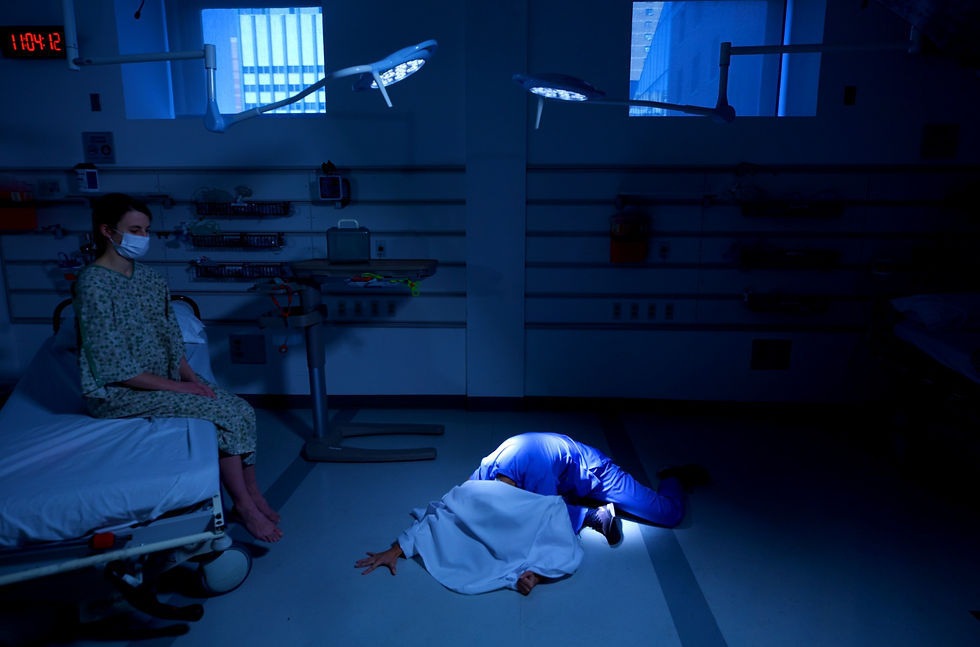
ORIGINATOR'S STATEMENT
I entered my Manhattan apartment around midnight, roughly an hour after observing a transplant team recover kidneys and a liver from a young patient newly pronounced dead. Still wearing scrubs, I sat down on my bed, and, like a ghostly twin or guardian angel, watched myself spill tears.
The scene I witnessed in the operating room that evening as a second-year medical student was at once grotesque and hallowed, shocking and valiant in its intensity. Surgeons fought time for organs capable of saving life while a life bled free before them. A body turned cold to my touch. In its rawness and severity, this experience served, among other things, as an initiation: an initiation into the inner, emotional world of medical providers.
Over the next several years, my familiarity with this world grew. I explored its depths and shallows in the capacity of student-doctor. Quickly, I recognized how significantly this world shapes physicians’ day-to-day existence, and, by extension, patient care. Though diversely lived, certain internal struggles seemed ubiquitous among trainees and clinicians. A set of emotional experiences appeared to bind providers in a mutual—but muted—understanding.
Indeed, it was rare for me to hear physicians openly discuss the emotional experience of medical practice. The weekly “debrief” sessions required on my internal medicine clerkship, however, were designed for precisely such conversation. I was grateful to hear choruses of “same here!” and “me, too!” following peers’ anecdotes and reflections. The stories my classmates told unveiled a range of emotional conflicts and frustrations encountered in the clinical setting—from unrelenting pressures of limited time, to feelings of helplessness in the face of bureaucratic-legal obstacles. Their experiences were consistently recognizable and relatable. I felt heard, safe and unlonely. But I wondered: were we alone in this unloneliness? Did other trainees and clinicians have sufficient opportunities to unpack whatever internal “tensions” rattled their day, week, year? Could they name those tensions aloud, tease them apart with trusted others? How might such tensions, especially if unacknowledged or pent, negatively affect physicians’ mental health?
Scholarly Backdrop
The mental health crisis among medical providers in the United States is a topic frequently discussed and written about. Numerous studies reveal that physicians are at elevated risk for mental health challenges, with “higher rates of burnout, depressive symptoms, and suicide risk than the general population" (1). Striking statistics—between three and four hundred physician suicides per year, one in every four residents poised to experience a major depressive episode while training—illuminate the severity of this crisis (2). Like most “big issues,” this one is extraordinarily multifaceted, with innumerable known and unknown inputs. Quantifiable factors, such as administrative workload and system inefficiencies, are often cited as causal. But the unquantifiable tolls of clinicians’ inner lives—and of silence around them—are an absolutely critical component of the equation.
So, in my final year of medical school, tasked with completing a “Scholarly Concentration” that “delve[s] deeply into a field of medicine that matches [my] professional interests,” I chose to explore the contents of physicians’ inner lives—and the lives of those lives (3). I sought to probe not only the nature of emotional challenges physicians face in our medical system, but also the internal, lived experience of those challenges. I set out to capture the expressive heart of various ethical-humanistic tensions clinicians may encounter, with the ultimate goal of stimulating discussion in the medical community around the many nuanced factors influencing provider mental health.
Creative Context
As a medium for this exploration, I selected a combination of photography, dance and writing. Such interdisciplinary work is not new for me. Building on years of pre-professional ballet training, I started my medical school career with a project formally establishing a novel subfield within the medical humanities—Movement and Medicine—at the intersection of medicine and dance (4). This work emphasized “clinically-relevant skills such as physical self-awareness, observation, communication, and mindfulness” that learners across the medical education spectrum stand to gain from engagement with movement arts (4).
In this present work, I build on the concepts behind Movement and Medicine, further expanding dance’s role as an educational tool and vehicle for embodied knowledge within the medical humanities. Photography is leveraged as a succinct means of “seeing out loud,” rendering tensions concrete and in action through visual depiction.
Project Aims
At the outset of this project, I hypothesized that, with deliberate creative execution and accompanying scholarly content, a photographic exhibit leveraging dancers’ physical expressivity could shed new light on the complexity of physicians’ inner lives and their unrecognized—or under-disclosed—impact on provider mental health and patient care.
My specific aims were threefold:
To identify and name ten troublesome internal “tensions” that medical providers may face in the provision of clinical care.
To create a photographic exhibit abstractly representing potential internal experiences of those tensions.
To amplify the photographs’ impact with narratives functioning as “mini-essays”—living scholarship germane to provider mental health that works in tandem with art to push boundaries of genre and discipline.
I invite you to view the following photographs and writings with these aims in mind. I hope you find inspiration, comfort, a little discomfort, and a higher level of self- and communal awareness as you look, read and contemplate.
Nina Shevzov-Zebrun
References
Moutier C. Creating a Safety Net: Preventing Physician Suicide. AAMC. https://www.aamc.org/news-insights/creating-safety-net-preventing-physician-suicide#:~:text=Physicians%20and%20trainees%20have%20higher,physicians%20experienced%20significant%20depressive%20symptoms.
10 Facts about Physician Suicide and Mental Health. American Foundation for Suicide. Prevention. https://www.acgme.org/globalassets/PDFs/ten-facts-about-physician-suicide.pdf
MD Degree Scholarly Concentrations. NYU Grossman School of Medicine, NYU Langone Health. https://med.nyu.edu/education/md-degree/md-curriculum/stage-three-individualized-exploration/scholarly-concentrations
Shevzov-Zebrun N, Barchi E and Grogan K. “The Spirit Thickened”: Making the Case for Dance in the Medical Humanities. Journal of Medical Humanities. 2020;41(4):543-560.